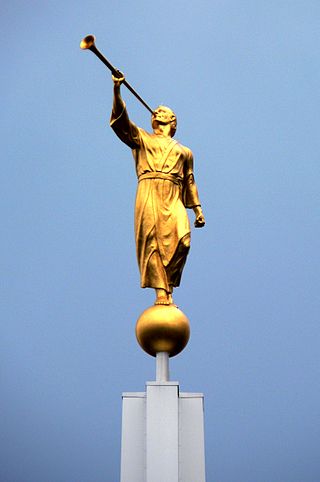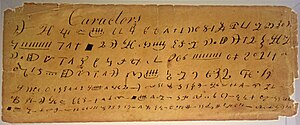
The Book of Mormon is a religious text of the Latter Day Saint movement, first published in 1830 by Joseph Smith as The Book of Mormon: An Account Written by the Hand of Mormon upon Plates Taken from the Plates of Nephi. According to Smith's account and the book's narrative, the Book was originally engraved in otherwise-unknown characters on golden plates by ancient prophets; the last prophet to contribute to the book, Moroni, had buried it in what is present-day Manchester, New York and then appeared in a vision to Smith in 1827, revealing the location of the plates and instructing him to translate the plates into English. The more widely accepted view is that Smith authored the Book, drawing, consciously or subconsciously, on material and ideas from his contemporary 19th-century environment, rather than translating an ancient record.

The Angel Moroni is an angel whom Joseph Smith, founder of the Latter Day Saint movement, reported as having visited him on numerous occasions, beginning on September 21, 1823. According to Smith, the angel Moroni was the guardian of the golden plates buried near his home in western New York, which Latter Day Saints believe were the source of the Book of Mormon. An important figure in the theology of the Latter Day Saint movement, Moroni is featured prominently in its architecture and art. Besides Smith, the Three Witnesses and several other witnesses also reported that they saw Moroni in visions in 1829.
The Book of Ether is one of the books of the Book of Mormon. It describes the Jaredites, descendants of Jared and his companions, who were led by God to the Americas shortly after the confusion of tongues and the destruction of the Tower of Babel. Ether consists of fifteen chapters.

The Book of Mormon, a work of scripture of the Latter Day Saint movement, describes itself as having a portion originally written in reformed Egyptian characters

The Book of Mormon is the name of a book, or subdivision, of the larger Book of Mormon. This "inner" book has nine chapters. According to the text, the first seven chapters were abridged by the prophet Mormon and the last two by his son Moroni.

According to Latter Day Saint belief, the golden plates are the source from which Joseph Smith translated the Book of Mormon, a sacred text of the faith. Some accounts from people who reported handling the plates describe the plates as weighing from 30 to 60 pounds, gold in color, and composed of thin metallic pages engraved with hieroglyphics on both sides and bound with three D-shaped rings.

Cumorah is a drumlin in Palmyra, New York, United States, where Joseph Smith said he found a set of golden plates which he translated into English and published as the Book of Mormon.

Mormon is believed by members of the Church of Jesus Christ of Latter-day Saints to be a prophet-historian and a member of a tribe of indigenous Americans known as the Nephites, one of the four groups described in the Book of Mormon as having settled in the ancient Americas.

According to the Book of Mormon, the Anti-Nephi-Lehies were an ethnic group of Lamanites formed around 90 BC, after a significant religious conversion. They made a covenant that they would not participate in war, and buried their weapons. Eventually they changed their name to the people of Ammon, or Ammonites. During a later period of warfare, the young men of the group who had not made the pacifist covenant became a military unit known as the two thousand stripling warriors, and were protected by divine intervention.

According to the Book of Mormon, the plates of Nephi, consisting of the large plates of Nephi and the small plates of Nephi, are a portion of the collection of inscribed metal plates which make up the record of the Nephites. This record was later abridged by Mormon and inscribed onto gold plates from which Joseph Smith translated the Book of Mormon after an angel revealed to him the location where the plates were buried on a hill called Cumorah near the town of Palmyra, New York.

The Book of Mormon contains many linguistic similarities to the King James Bible (KJV). In some cases, entire passages are duplicated in the Book of Mormon. Sometimes the quotation is explicit, as in the Second Book of Nephi, which contains 18 quoted chapters of the Book of Isaiah.

Moroni is described in the in the Book of Mormon as the last Nephite prophet, historian, and military commander who, according to the faith of the Latter Day Saint movement, became the Angel Moroni who presented the golden plates to Joseph Smith.
In the Book of Mormon, Zenock is a prophet who predates the events of the book's main plot and whose prophecies and statements are recorded upon brass plates possessed by the Nephites. In the narrative, Zenock is a descendant of Joseph, and he is also an ancestor of the Nephites. Narrators of the Book of Mormon and Nephite prophets quote or paraphrase Zenock several times in the course of the text, including Nephi, Alma, son of Alma, Amulek, Nephi, son of Helaman, and Mormon. Zenock's teachings as referenced in the Book of Mormon include prophesying about the Messiah, describing his death and aligning that with something that Mormons believe is like the Christian doctrine of salvation, and rebuking people who reject that message. In the Book of Alma, Alma reports that Zenock was stoned to death for preaching that the Messiah would be the "Son of God."

Adherents to the Latter Day Saint movement view the Book of Mormon as a work of divinely inspired scripture, which was written by ancient prophets in the ancient Americas. Adherents mostly believe Joseph Smith's account of translating ancient golden plates inscribed by prophets. Smith preached that the angel Moroni, a prophet in the Book of Mormon, directed him in the 1820s to a hill near his home in Palmyra, New York, where the plates were buried. An often repeated and upheld as convincing claim by adherents that the story is true is that besides Smith himself, there were at least 11 witnesses who said they saw the plates in 1829, three that claimed to also have been visited by an angel, and other witnesses who observed Smith dictating parts of the text that eventually became the Book of Mormon.

The origins, authenticity, and historicity of the Book of Mormon have been subject to considerable criticism from scholars and skeptics since it was first published in 1830. The Book of Mormon is a sacred text of the Latter Day Saint movement, which adherents believe contains writings of ancient prophets who lived on the American continent from approximately 2200 BC to AD 421. It was first published in March 1830 by Joseph Smith as The Book of Mormon: An Account Written by the Hand of Mormon upon Plates Taken from the Plates of Nephi, who said that it had been written in otherwise unknown characters referred to as "reformed Egyptian" engraved on golden plates that he personally transcribed. Contemporary followers of the Latter Day Saint movement typically regard the text primarily as scripture, but also as a historical record of God's dealings with the ancient inhabitants of the Americas.

Mosiah priority is a theory about the creation of the Book of Mormon arguing that the original manuscript began not with 1 Nephi, but midway through, starting with Mosiah. According to Mosiah priority, after the text of Mosiah through the end of the Book of Mormon was transcribed, Joseph Smith returned to the beginning and transcribed 1 Nephi through Words of Mormon. Mosiah priority is the most widely held solution to questions regarding the sequence of the English text.

The following outline is provided as an overview of and topical guide to the Book of Mormon:

The lineage of Alma the Younger is a set of minor figures from the Book of Mormon who descended from Alma the Younger. They are described as Nephite record-keepers, missionaries and prophets.







